Related Research Articles

Chhattisgarh is a landlocked state in Central India. It is the ninth largest state by area, and with a population of roughly 30 million, the seventeenth most populous. It borders seven states – Uttar Pradesh to the north, Madhya Pradesh to the northwest, Maharashtra to the southwest, Jharkhand to the northeast, Odisha to the east, Andhra Pradesh and Telangana to the south. Formerly a part of Madhya Pradesh, it was granted statehood on 1 November 2000 with Raipur as the designated state capital.

The Gondi (Gōṇḍī) or Gond people, who refer to themselves as "Kōītōr", are an ethnolinguistic group in India. Their native language, Gondi, belongs to the Dravidian family. They are spread over the states of Madhya Pradesh, Maharashtra, Chhattisgarh, Uttar Pradesh, Telangana, Andhra Pradesh, Bihar, and Odisha. They are listed as a Scheduled Tribe for the purpose of India's system of reservation.

Bastar is a district in the state of Chhattisgarh in Central India. Jagdalpur is the district headquarters. Bastar is bounded on the northwest by Narayanpur District, on the north by Kondagaon district, on the east by Nabarangpur and Koraput Districts of Odisha State, on the south and southwest by Dantewada and Sukma. The district possesses a unique blend of tribal and Odia culture.

Chhattisgarh is a state of India with strong tribal traditions of music and dance. The state of Chhattisgarh is best known for its deep roots in folk music, which originated from its long history of tribal involvement.

Bastar division is an administrative division of Chhattisgarh state in central India. It includes the districts of Bastar, Dantewada, Bijapur, Narayanpur, Sukma, Kondagaon and Kanker.

Uttar Bastar Kanker District is located in the southern region of the state of Chhattisgarh, India within the latitudes 20.6-20.24 and longitudes 80.48-81.48. The total area of the district is 6432 square kilometers. The population is 748,941.

Bhupesh Baghel, popularly known as Kaka, is an Indian politician who served as the 3rd Chief Minister of Chhattisgarh from 2018 to 2023. He was president of Chhattisgarh Pradesh Congress from 2014 to 2019. He represented the Patan constituency in the Chhattisgarh Legislative Assembly since 2013 and from 2003 to 2008. He had been cabinet minister of Transportation in undivided Madhya Pradesh in Digvijaya Singh government from 1999 to 2003. He was first Minister for Revenue, Public Health Engineering and Relief Work of Chhattisgarh.
The Halba are a tribe in Chhattisgarh, Maharashtra, Madhya Pradesh and Odisha in India. They speak the Halbi language and mostly farm. They are a mixed tribe descended from Gonds and Hindus. Linguistic evidence indicates they are an aboriginal tribe who adopted Hinduism and an Indo-European language.

Nava Raipur, officially known as Atal Nagar-Nava Raipur, is a planned city and fully Greenfield city in Indian state of Chhattisgarh. It is planned to replace Raipur as the capital city of Chhattisgarh. The Government of Chhattisgarh, the state's administrative body is situated here. The city is located between National Highway 53 and National Highway 30, about 17 km south-east of the capital city Raipur. Swami Vivekananda Airport separates Raipur and Nava Raipur.
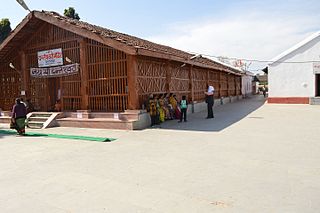
Danteshwari Temple is Hindu temple, dedicated to Goddess Danteshwari, and is one of the 52 Shakti Peethas, shrines of Shakti, the divine feminine, spread across India. The temple built in the 14th century, is situated in Dantewada, a town situated 80 km from Jagdalpur Tehsil, Chhattisgarh. Dantewada is named after the Goddess Danteshwari, the presiding deity of the earlier Kakatiya rulers. Traditionally she is the Kuldevi of Bastar state,
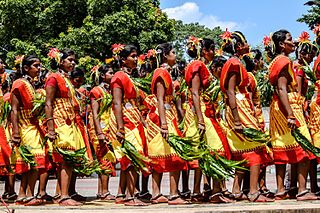
Karma dance or Karma Naach is a traditional dance of central and Eastern India annually performed during the karma festival. Karma is a famous autumnal festival, it starts from the 11th day of the bright fortnight of the month of Bhadrab. It is performed in State of Chhattisgarh, Jharkhand, Madhya Pradesh, Odisha and West Bengal. Karma means 'fate'.
The culture of Northern Cyprus is the pattern of human activity and symbolism associated with Northern Cyprus and Turkish Cypriots. It features significant elements influenced by or developed upon the culture of Turkey, but combines these elements with a unique Cypriot approach and local traditions, as well as several other influences, such as the British and contemporary western cultures.
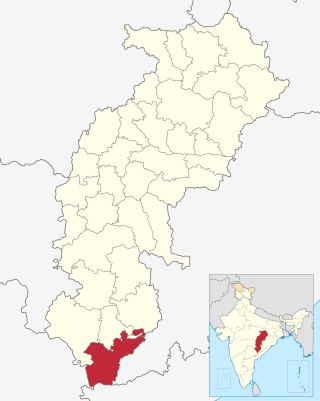
Sukma district is the southernmost district in the Indian state of Chhattisgarh. It is located in the Bastar region, known for its tribal culture. Sukma district borders with Odisha, Telangana and Andhra Pradesh.

Bastar Dussehra is the unique cultural trait of Chhattisgarh. Celebrated by the local people of the state with sufficient vigor, the festival of Dussehra connotes to the supreme power of goddess Danteswari, the revered deity of all the existing tribes of Chhattisgarh. During Dussehra, the inhabitants of Bastar organizes special worship ceremonies at the Danteswari temple of Jagadalpur. On this occasion rath is made in which goddess sits.
Madai festival is one of many popular festivals of Sanskritik Chhattisgarh. The festival reflects the rich culture and tradition of the state. The Madai Festival is celebrated with great enthusiasm and excitement by people belonging to the Gond Tribe. It is celebrated from the month of December to March and tours from one place of the state to another. The Charama and Kurna communities of Kanker district, tribes of Bastar and people of Bhanupratappur, Narayanpur, Kondagaon, Pakhanjore and Antagrah celebrate the Madai Festival in the state of Chhattisgarh.
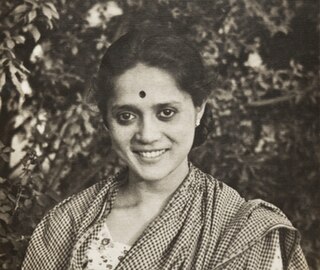
Meera Mukherjee (1923–1998) was an Indian sculptor and writer, known for bringing modernity to the ancient Bengali sculpting art. She is known to have used innovative bronze casting techniques, improving the Dhokra method employing Lost-wax casting, which she learnt during her training days of the Bastar sculpting tradition of Chhattisgarh. She received the fourth highest civilian award of the Padma Shri from the Government of India in 1992 for her contributions to Arts.
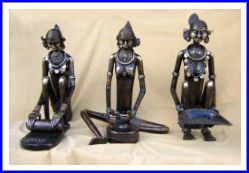
Bastar wooden crafts are traditional Indian wooden crafts that are manufactured in the Bastar district of Chhattisgarh state, India. The wood-crafting work has been protected under the Geographical indication (GI) of the Agreement on Trade-Related Aspects of Intellectual Property Rights (TRIPS) agreement. It is listed at item 84 as "Bastar Wooden Craft" of the GI Act 1999 of the Government of India with registration confirmed by the Controller General of Patents Designs and Trademarks.
Chhattisgarh embraces a diverse cultural and traditional practices in India. As the state government has taken meticulous steps to preserve the tribal culture, these festivals and the traditions are celebrated almost from the time of ancient India.
The New Peace Process is an initiative of a conglomerate of tribal and non-government support groups and individuals, with the aim of bringing a negotiated settlement to the 50-year-old Maoist insurgency in Central India. Bastar Dialogues are a series of activities that started in mid 2018 by the New Peace Process to initiate a dialogue between the Naxalites and state security forces to restore peace in Central India.

The Tribal Museum of Bhopal or Madhya Pradesh Tribal Museum is located close to the State Museum, Bhopal, near the Museum of Man/ Museum of Mankind in the Indian state of Madhya Pradesh. This is a museum dedicated to the living aspects of tribal life, indigenous knowledge systems, and aesthetics.
References
- ↑ Bastar Lokostav (PDF). Chhattishare. p. 3. Retrieved August 10, 2015.
- ↑ "Baster Lokostav". Archived from the original on 27 March 2015. Retrieved 14 April 2015.
{{cite web}}: CS1 maint: unfit URL (link) - ↑ Culture and Festivals of Chhattisgarh. "lokostav" . Retrieved 14 April 2015.